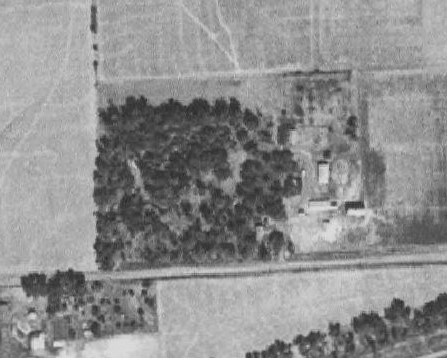We’ve decided to build a new building to serve as a shop. But before we can do that, we have to clear the space where the shop will stand. In that space are trees that must be taken down, including two particularly tricky ones, a hackberry tree and an American elm. Along with the trees is the rubble from what appears to be a building that was demolished at some point in the past and moved to this out of the way place to be dumped. This is not an uncommon practice for disposing of things like brick and cement on an Iowa farm—just shove it into the woods and leave it. We’ve decided to clean it up, now and take it all to the city landfill where they will dispose of it properly.
But what is in this rubble pile, and what did it used to be? We find a few clues. The bricks are red bricks with three holes in each for mortaring them together. They still contain traces of whitewash. The cement chunks appear to be composed of a three-inch layer of coarse-mix cement and a three-quarters top layer of fine mix cement. Stamped into one chunk of the cement is the word Rippetoe and half of what is probably the name of our town. Another find is a concrete double sink, with holes for pipes and a drain board on one side. It’s all broken up, but if you fit it back together in your mind, you can construct—a milk house? Our barn is a dairy barn, so a milk house is a logical conclusion for us as amateur archeologists. And a bit more sleuthing discovers a mason named Rippetoe working in this area at least from 1905 to 1930. The builder of the milk house?
It is likely, given Iowa history, that there were milk cows on Owl Acres beginning with the earliest settlers. A cow would provide a family with milk and butter throughout the spring, summer and fall. The women and children would handle the milking, butter churning, cheese-making, and in some cases sales of excess product to neighbors, local merchants, or traveling butter dealers.
In the 1860s, cheese factories sprang up, serving farmers within a three-mile radius and providing some cash income for the farm. So it made sense to increase the number of milk cows and, over time, to improve the breed to produce more milk. But the other decision that made sense at the time was to switch from growing wheat to growing corn and raising hogs. The skim milk left after cream was taken off was an important hog feed at the time, so farmers kept it after separating the cream. The cream, then, was taken to the creameries where instead of cheese, it was turned into butter. The butter was then shipped east by railroad for sale in Chicago and eastern cities. By 1890 when the Dammeier brothers bought Owl Acres and its surrounding land, cheese factories had given way to creameries.
By 1915 the Dammeiers had built a dairy barn with room for up to 21 cows to be milked at a time. The fresh milk would be taken to the near by milk house. The purpose of the milk house was to keep the milk in a clean environment away from the barn and its dust. In the milk house, the fresh milk would be cooled and stored in cans for transport to the local creamery. The milk house was most likely one of the three small buildings visible in a 1930s-vintage aerial photo of Owl Acres. It would have been a small building close to the barn with a cement floor capped with mortar for easy washing, as sanitation was critical. The walls would have been built of the red brick and then whitewashed, and it most likely had a gabled roof. In the milk house would be a cooling tank where the milk was poured to cool down. The wash sink we found would have been crucial in washing equipment to maintain sanitation, and some space would have been reserved for storage of cans of milk. By 1915 or so, the milk would have been separated on the farm using a cream separator. The cream would have been collected and processed at the near-by creamery into butter, and the skim milk would have been fed to the hogs.
A 1930 aerial photo of Owl Acres indicates three small buildings in the area near the barn. One of these was most likely the milk house. I wonder what the other two are.
Photo from the Iowa DNR Aerial Photography Project. Alt text: Photo shows the Owl Acres property as it appeared from the air in 1930. The barn which still stands today, casts its shadow near the lower right corner. Five other outbuildings can be seen near the barn, and three of them cast tiny shadows. We think one of the little buildings was the milk house.

2 comments
I love the history!
It is so neat to learn and visualize the history of your property.